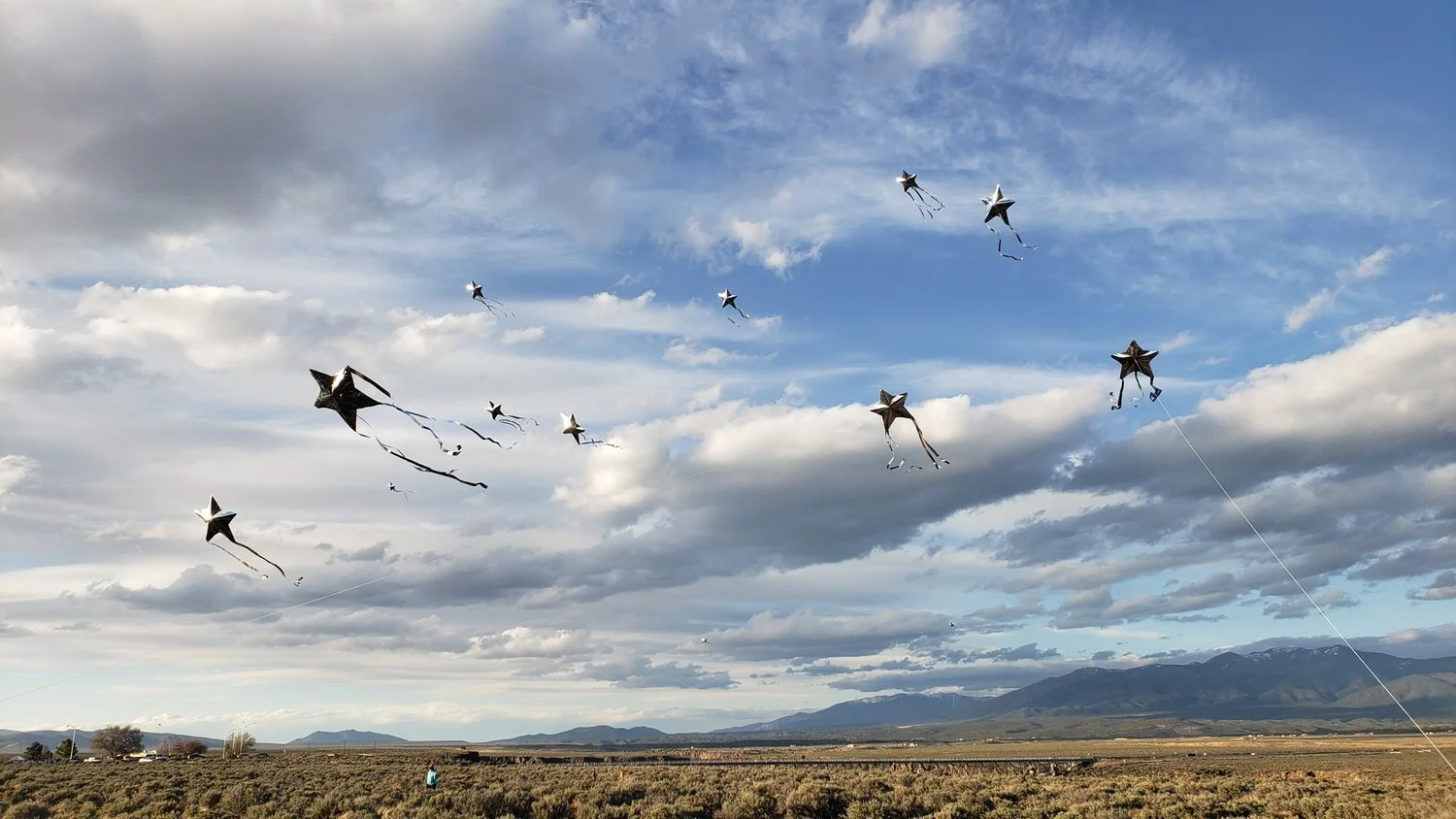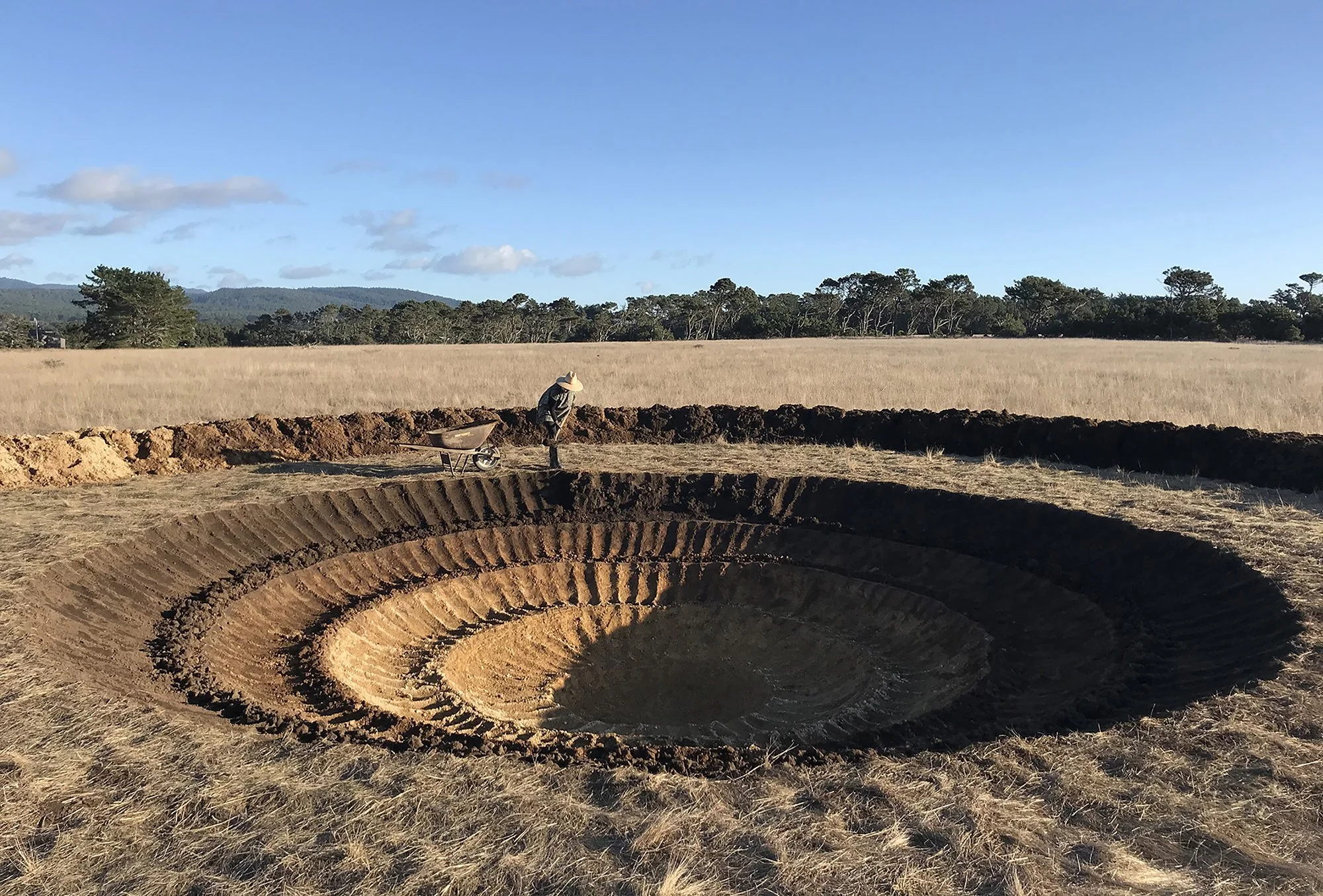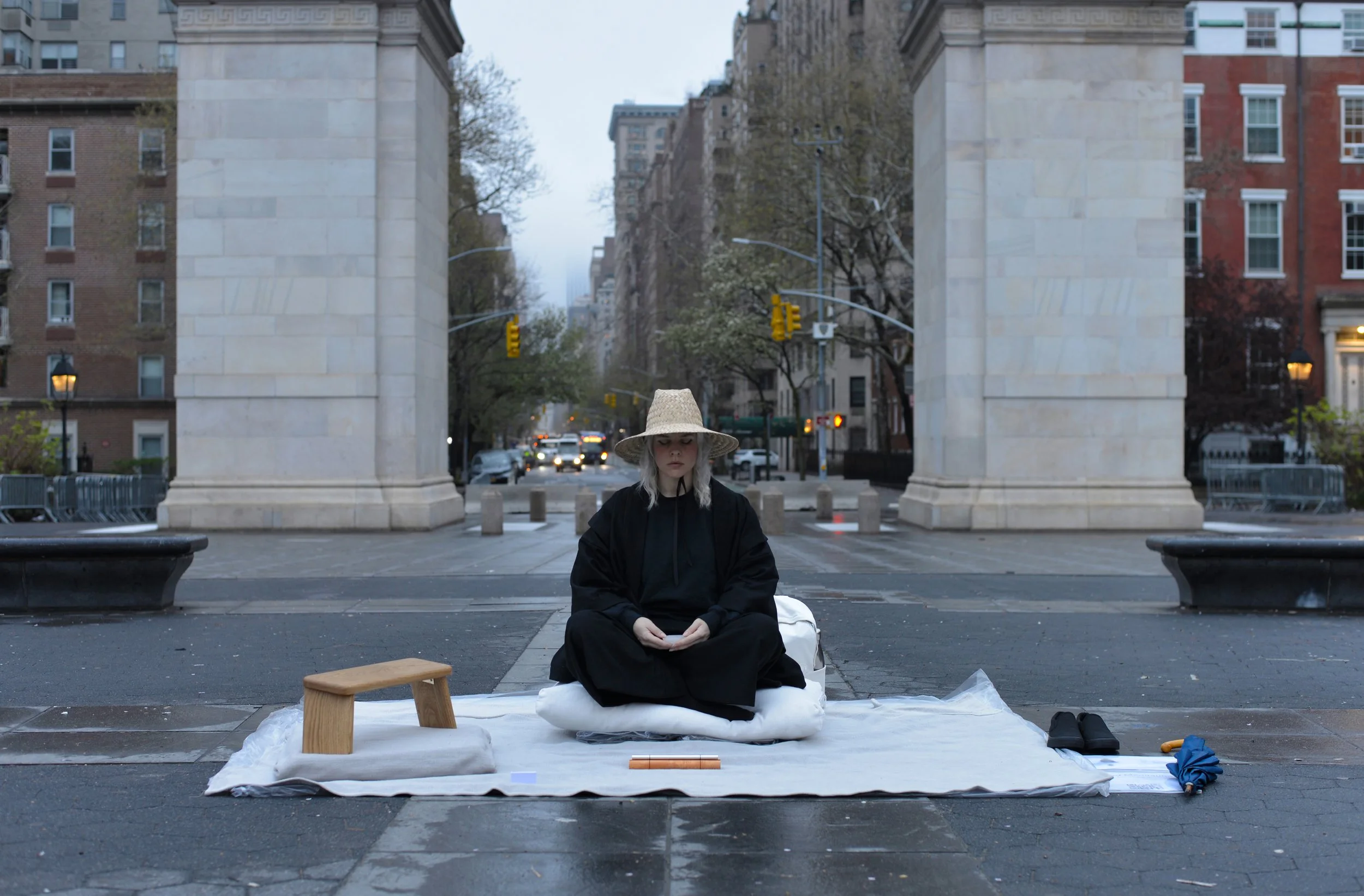The Making with artist Jemila MacEwan
Sun Seeds, Community land art performance, Taos, NM, 2023
Jemila MacEwan is an artist whose practice shimmers like a prayer. MacEwan creates astounding, ecologically informed works, including 'Human Meteorite,' a month-long endurance performance that resulted in a 72-foot wide, six-foot deep crater and 'Sun Seeds,' a reflective spectacle of light made with 250 children flying silver kites. Their works show deep reverence for the natural world and express the longing many of us share: for a planet that is cared for and endures for future generations.
MacEwan exhibited and performed at Essex Art Center in the winter of 2022-23. In this interview, Executive Director Monica Lynn Manoski dives deep into MacEwan’s practice and learns more about the artist’s recent performance, 'Seed Meditation,' which lasted ten days and was surprisingly intimate in scale––with the main action unfolding in the palm of the artist's hands.
Monica Lynn Manoski
Every piece you make has this sense of devotion, or what one could call religiosity. What was the spiritual background of your childhood, and has it seeped into your life and practice today?
Human Meteorite, Land art endurance performance, Day 30 of 30, Point Arena, CA, 2017
Jemila MacEwan
Being an artist allows me to have a spiritual practice independent of institutions and religions. My approach to spiritual practice prioritizes the creative process as a teacher rather than following a pre-prescribed set of rules or conditions. My parents co-founded a school for Sufism and esoteric study. As children, my siblings and I weren't necessarily raised Sufi, but there were a lot of concepts within Sufism, such as being curious, exploratory, and expansive, that opened up my relationships and understanding of the world. My parents were polymaths; my dad is a soil scientist and very knowledgeable about growing plants and building things. My mom worked in childcare and knew a lot about history, mythology, and psychology. Growing up in Scotland, I was exposed to indigenous plant knowledge, and in Australia, I was taken into the country by Nundjan Djiridjarkan, an indigenous elder who shared the story of that land's creation, which is always happening. These encounters influenced me greatly. I hold an expansively interdisciplinary approach to the work that I create, where knowledge systems aren't separate, where the spiritual is not isolated from science, and the sacred is grounded with the mundane. Throughout my adult life, I've come to understand that what I am is an artist, which gives me the freedom to wield many disciplines.
MLM
In your most recent work, you meditated for ten days in Washington Square Park from sunrise to sunset, holding a seed in the palm of your hand. By day ten, the seed had germinated. You've made several works that take the form of meditation, including the 'Mycelium Mediation' and 'Mollusk Mediation,' which you performed at Essex Art Center. Can you tell us more about meditation as an art form and why you chose a seed as your focal point in your most recent work?
Seed Meditation, Day 1: Black, “Black is the image of Space,” Washington Square Park, April 12, 2024
JM
I see meditation as a creative form, just like performance art or land art. In my "ecomorphic meditations," I extend myself to become more-than-human. In each example, the meditation teacher or guru is an entity from the natural world, and the meditation fits the lessons the entity offers. 'Mycelium Meditation,' for example, was a very loud performance. It involved several collaborators, including two music collaborators, Matt Evans and Jack Helfrich, and I had two food collaborators, Jimmy Tran and Jemma Brown. 'Mollusk Meditation,' which I performed at Essex Art Center, is funny, weird, and exploratory. The 'Seed Meditation' that I performed in April in Washington Square Park resembles what people would consider a traditional meditation practice in that it was quiet and contemplative. I chose to do it that way because it is what the seed needed.
MLM
There's so much symbolism in this seemingly simple piece. Can you talk about that, how you came up with the idea, and what you did to prepare?
JM
The idea itself is initiated by a deeply personal, primal need. In this case, it came out of a period of complete exhaustion, an exhaustion that unfolded into depression. The thing about these states where we're exhausted and depressed is that they're incredibly limiting. Our mental, emotional, and physical limits have been met, and we must retreat. To repair myself, I was doing a lot of meditation. But I also found that I felt very isolated and alone. One of the ways I combated that was by imagining myself supported by various people in my life. As I germinated out of this period of depression, I imagined what would give these individuals a purpose in real life to support me. I saw myself working to germinate a seed, and that seed was reflecting what was happening inside me. Just imagining making this work elevated me so much. The symbolism emerged from all of the human states and conditions I grappled with during this time. I needed ways to contend with conditions of fear, doubt, control, jealousy, grief, competitiveness, anger, pride and disillusionment. ‘Seed Meditation’ is a reflection of Divine Love, and each of the ten days, I wore a different color to represent an elemental theme: black fo space, brown for earth, blue for water, green for germination, pink for blossom, purple for wound, yellow for midday sun, orange for setting sun, red for rising sun, and white for light.
MLM
The online art platform Hyperallergic covered 'Seed Meditation' and asked about your choice to engage in noble silence when people are being called upon to use their voices. I loved your response and wanted to ask you to elaborate on the idea of plants, seeds, and the earth as our teachers.
Seed Meditation, Day 4 detail: Green, “Green is the image of life,” April 15, 2024
JM
Humans get really caught up in the human drama that is unfolding. This historic moment we're confronting is unique to us because the conditions—the politics, technology, etc.—are unique to our time. The same is true of the natural world. Even though there are always cycles of renewal, evolution is always slightly shifting. Ecosystems and climate are constantly changing and becoming new. Being a student of ecosystems and seeing other species as teachers, I've come to see that our own species' concerns consume us. Of course, what we sense feels very urgent, yet when we amplify our conflicts, our suffering also becomes amplified. In that way, it starts to affect our personal lives, and we become suffocated by it because there is no room to recognize the joy and the love, which are equally important. In addition, our perception of what is happening lacks relationality to other non-human processes that are occurring around us.
The ideal thing to do is to break away from inward-looking and inward-species perspectives and find support from our interspecies siblings. Anytime we create conflict, whether personal, political, or global, the solution should be to dilate one's perspective to take in more of the world, more people, and more of the living planet and its natural systems.
During 'Seed Meditation,' the seed was my teacher. I believe in the power of the small. When we think about protest art and impact, I often return to the belief that it's sustained commitment that drives transformation, not scale. People often need to be reminded that something tiny can have an immense impact. When you draw your attention to something small, like a seed, and the process of the single seed germinating, it allows you to meditate on everything connected to it. You expand from this single point to seeing everything that supported life thus far. The material universe and all the conditions that make it possible for one seed to germinate remind you that a vast amount of support exists for something very small.
Seed Meditation Day 5: Pink, “Pink is the image of a blossom,” April 16, 2024
MLM
How did making this piece change you?
JM
There were a few days right afterward that I felt quite amazing, but it affected my whole body, sleep cycle, and more. There was a lot that I experienced psychically, somatically, and emotionally that I didn't get to process during the performance because every night, I would come home and be out cold and then wake up and do it all again. Because of all the meditation, I found myself hovering in this semi-dreamlike state, and most nights after the performance, when I went to sleep, I am transported back to the park. It's very surreal.
The Wake, 29-minute film, Falljökull Glacier, Iceland, 2019
MLM
Your work, such as 'The Wake,' often expresses ecological heartbreak. How would you classify ‘Seed Meditation?’ Are you feeling more optimistic about our shared future?
JM
There is a Buddhist incantation I have been keeping with lately, "Om Mani Padme Hum," which roughly translates to "I in the jewel of the lotus." I think about optimism this way. To me, a resilient state of optimism comes from sitting within this central point––a balanced axis of being from which all the petals of perceivable reality unfold. Optimism is a deep trust and belief in the creative as the underlying condition of existence. I think another name for optimism is love. My deep love for life, the power of the creative, and all of existence support me when I make a work like 'The Wake' for which I walk with the collective state of ecological grief. I made this work with the understanding that grief is an expression of love. 'Seed Meditation' was rooted in the optimism that all the conditions we suffer as humans, such as fear, doubt, grief, etc., are gateways towards experiences of divine love. For example, on day eight of 'Seed Meditation,' when I wore orange, I contemplated how one must experience anger to know divine love in the form of forgiveness. The guiding principle within 'Seed Meditation' is that all existence is available to support us on that journey toward knowing divine love.
You can delve deeper into Seed Meditation by reading the accompanying text that Jemila created.
About the Artist
Jemila MacEwan’s 10-year solo exhibition, Human Meteorite, ran at Essex Art Center 2022-23. They were a TEDxBoston Planetary Fellow and awarded the NYSCA/NYFA Fellowship in Architecture/Environmental Structures/Design, The Philip Hunter Environmental Art Fellowship, and The BigCi Environmental Art Award. They attended notable residencies, including Skowhegan School of Painting and Sculpture (USA), Art OMI (USA), BANFF Center (Canada), NARS Foundation (NYC), and Ox-Bow School of Painting (MI). Their work has been published in Art in America, Boston Globe, SFMoMA Open Space, MONDO arc, and Artist Profile Magazine. MacEwan has been generously supported by the Foundation for Contemporary Arts, the Australia Council for the Arts, the New York Foundation for the Arts, the New York State Council on the Arts, the Ian Potter Cultural Council and is a recipient of The Marten Bequest Traveling Scholarship. You can learn more about their work by visiting their website or following them on Instagram.







